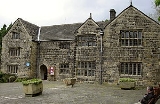
Manor House Museum
Encyclopedia
Manor House Museum, Ilkley
, England
, is a local heritage museum
, art gallery
and education centre
, established in 1892 to preserve local archaeological
artefacts after the spa town
expanded and much Roman
material was lost. It was re-opened in the present building in 1961. Admission to the Museum is free of charge.
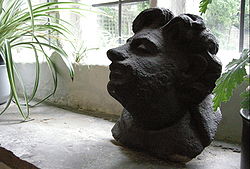
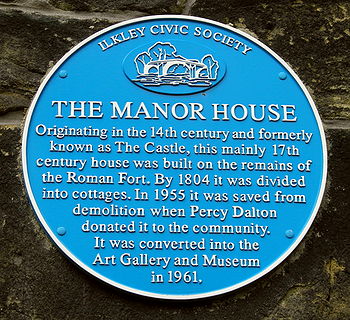
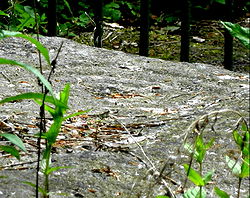
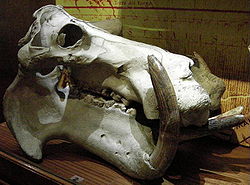 The following are some key early exhibits at the museum:
The following are some key early exhibits at the museum:
triple vase is not always on display for that reason, although it attracts visitors because it is the one item which has been consistently listed in reports of the collection since 1892.
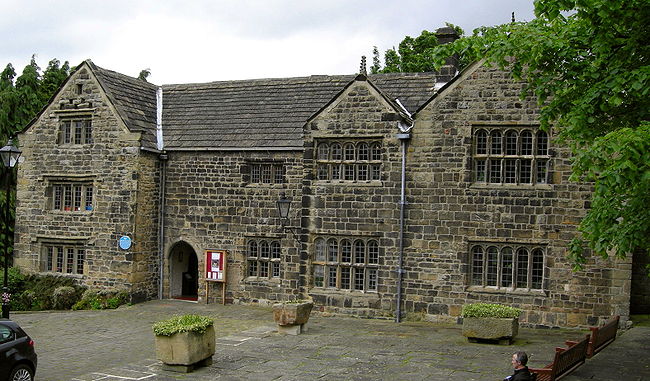 The Manor House building is of historic interest.
The Manor House building is of historic interest.
The building stands on a Roman fort. This is the oldest dwelling-house in Ilkley and was built along with the parish church
on the fort Olicana
. The church was built in Anglo-Saxon
times on top of the Principia or headquarters building of the fort
. The Manor House was built into the west defences: that is, it was incorporated with part of the free-standing defensive west wall of the fort
, and many robbed-out Roman
small squared stone blocks are now part of the building.
The front or south elevation. The building faces south. The left or west wing, where the Museum shop is situated, is partly medieval
and was built on the Roman
fort
wall. The interior entrance to the shop has a 14th century shouldered lintel
. The mullion
ed windows are 17th century. The central gable
covers the main eating hall
with fireplace, and the right or east gable is the solar
wing, containing upstairs accommodation for the owner, with a garderobe
and fireplace. The front walls and windows of the central hall
and solar
wing are 16th century. The front doorway with pointed arch is possibly late Norman
, 14th century.
The back or north elevation of the building is partly built with stones robbed out from the Roman
fort
. The passage doorway may be medieval
, but the archway and right (west) wing are 17th century. The wall beneath the central and east gables on this side is 15th to 16th century. The lowest large window in the solar
wing on this north side is 17th century; other north-elevation windows are more modern.
In the interior roof of the solar room
, the rigid 15th or 16th century structure
of king post
s, tie beams and principal rafter
s forms the main frame of the roof, as a series of triangular truss
es.
wing is used for educational purposes, especially when local schoolchildren are studying Roman history.
Ilkley
Ilkley is a spa town and civil parish in West Yorkshire, in the north of England. Ilkley civil parish includes the adjacent village of Ben Rhydding and is a ward within the metropolitan borough of Bradford. Approximately north of Bradford, the town lies mainly on the south bank of the River Wharfe...
, England
England
England is a country that is part of the United Kingdom. It shares land borders with Scotland to the north and Wales to the west; the Irish Sea is to the north west, the Celtic Sea to the south west, with the North Sea to the east and the English Channel to the south separating it from continental...
, is a local heritage museum
Museum
A museum is an institution that cares for a collection of artifacts and other objects of scientific, artistic, cultural, or historical importance and makes them available for public viewing through exhibits that may be permanent or temporary. Most large museums are located in major cities...
, art gallery
Art gallery
An art gallery or art museum is a building or space for the exhibition of art, usually visual art.Museums can be public or private, but what distinguishes a museum is the ownership of a collection...
and education centre
Museum education
Museum education is an important part of the role of museums.- Introduction :A museum's collection can be used to support education in a variety of ways...
, established in 1892 to preserve local archaeological
Archaeology
Archaeology, or archeology , is the study of human society, primarily through the recovery and analysis of the material culture and environmental data that they have left behind, which includes artifacts, architecture, biofacts and cultural landscapes...
artefacts after the spa town
Spa town
A spa town is a town situated around a mineral spa . Patrons resorted to spas to "take the waters" for their purported health benefits. The word comes from the Belgian town Spa. In continental Europe a spa was known as a ville d'eau...
expanded and much Roman
Ancient Rome
Ancient Rome was a thriving civilization that grew on the Italian Peninsula as early as the 8th century BC. Located along the Mediterranean Sea and centered on the city of Rome, it expanded to one of the largest empires in the ancient world....
material was lost. It was re-opened in the present building in 1961. Admission to the Museum is free of charge.
History of the museum
The following are key events in the history of the museum:- 1892: The museum was established in 1982 by the Museum Committee (president: Dr G. Carter) under the auspices of the Ilkley Ratepayers' Association. This had become urgent when the expansion of the spa town of Ilkley caused disturbance of RomanAncient RomeAncient Rome was a thriving civilization that grew on the Italian Peninsula as early as the 8th century BC. Located along the Mediterranean Sea and centered on the city of Rome, it expanded to one of the largest empires in the ancient world....
and other remains under the town. It was said that RomanAncient RomeAncient Rome was a thriving civilization that grew on the Italian Peninsula as early as the 8th century BC. Located along the Mediterranean Sea and centered on the city of Rome, it expanded to one of the largest empires in the ancient world....
material was being carried away by the cartload, and local antiquarians had been attempting to rescue and preserve some of these artefacts - but they had nowhere to display them. The present manor houseManor houseA manor house is a country house that historically formed the administrative centre of a manor, the lowest unit of territorial organisation in the feudal system in Europe. The term is applied to country houses that belonged to the gentry and other grand stately homes...
building, known as the "Old Castle" was the committee's first choice, but was too expensive, so they bought the Old WesleyanJohn WesleyJohn Wesley was a Church of England cleric and Christian theologian. Wesley is largely credited, along with his brother Charles Wesley, as founding the Methodist movement which began when he took to open-air preaching in a similar manner to George Whitefield...
Chapel (b.1834). The opening ceremony was on Thursday 25 August 1892. The Rev. Dr Collyer, who gave the opening speech, asked his audience to guard both the rescued artefacts and the archaeologicalArchaeologyArchaeology, or archeology , is the study of human society, primarily through the recovery and analysis of the material culture and environmental data that they have left behind, which includes artifacts, architecture, biofacts and cultural landscapes...
remains that were still buried under Ilkley. The first curator was Herbert Oxley, who was paid £1 per week. On 14 September it was renamed the Ilkley Museum and Antiquarian Society.
- 1896: Ilkley Urban District Council took over the museum. Oxley the curator died, to be replaced by his wife.
- 1908: The museum was moved to the upper floor of the new Public Library, which had been opened in 1907. William Graham took over as curator; he held the post until 1942.

- 1922: Donations had expanded the collection, but the museum could not afford to move to larger premises. An unmanageably large collection of non-local objects interfered with classification and display of its local core items: the RomanAncient RomeAncient Rome was a thriving civilization that grew on the Italian Peninsula as early as the 8th century BC. Located along the Mediterranean Sea and centered on the city of Rome, it expanded to one of the largest empires in the ancient world....
artefacts. Therefore the collection had to be reduced. Many non-local items were returned to owners or loaned to Cliffe Castle MuseumCliffe Castle MuseumCliffe Castle Museum, Keighley, West Yorkshire, England, is a local heritage museum which opened in the grand, Victorian, neo-Gothic Cliffe Castle in 1959. The museum is the successor to Keighley Museum which opened in Eastwood House, Keighley, in ca.1892. There is a series of galleries dedicated...
, KeighleyKeighleyKeighley is a town and civil parish within the metropolitan borough of the City of Bradford in West Yorkshire, England. It is situated northwest of Bradford and is at the confluence of the River Aire and the River Worth...
.
- 1939–1948: The museum exhibits were packed away to make room for wartimeWorld War IIWorld War II, or the Second World War , was a global conflict lasting from 1939 to 1945, involving most of the world's nations—including all of the great powers—eventually forming two opposing military alliances: the Allies and the Axis...
administration. The curator William Graham died and was not replaced. Items in storage became muddled together or went missing.
- 1949: The museum was re-established, with Grace Simpson restoring order, and Elsie Fletcher becoming Honorary Curator. It was reopened on 4 June 1949 as Ilkley Museum.
- 1954: Elsie Fletcher started the Olicana Museum Society, which later became the Olicana Historical Society. This society is in effect an extension of the original protective measures of the museum, in that it takes a keen interest in local archaeological and historical heritage, and organizes lectures and excursions.
- 1955–1961: The Old Castle — Manor House Museum's current building - became available to the Museum but was in a sorry state and required cash and conversion. Costs were quoted at £7,000-£10,000, but there were contributions from Ilkley Urban District Council and Percy Dalton, and a grant from the Ministry of Works. The present Manor House Museum and Art Gallery was opened on 8 July 1961.
- 1962–present: From 1963 both upper rooms have been art galleries. The caretakers lived upstairs at first, but in 1974 their rooms became offices. From 1966 to 1977 Arthur Kitching was curator and organiser of exhibitions. The restored Old Castle building itself became the main exhibit of the Museum, and from 1963 it has been supported by the Friends of the Manor House society. Since the Arts and Museums Division of the Bradford Metropolitan DistrictCity of BradfordThe City of Bradford is a local government district of West Yorkshire, England with the status of a city and metropolitan borough. It is named after its largest settlement, Bradford, but covers a far larger area which includes the towns of Keighley, Shipley, Bingley, Ilkley, Haworth, Silsden and...
was formed in 1974, the Manor House Museum has been able to get some of its lost exhibits back, and has benefited from communal museum resources.

Early exhibits


- 1893: The earliest exhibits were local geologicalGeologyGeology is the science comprising the study of solid Earth, the rocks of which it is composed, and the processes by which it evolves. Geology gives insight into the history of the Earth, as it provides the primary evidence for plate tectonics, the evolutionary history of life, and past climates...
and botanicalBotanyBotany, plant science, or plant biology is a branch of biology that involves the scientific study of plant life. Traditionally, botany also included the study of fungi, algae and viruses...
specimens, drawings of local stones with NeolithicNeolithicThe Neolithic Age, Era, or Period, or New Stone Age, was a period in the development of human technology, beginning about 9500 BC in some parts of the Middle East, and later in other parts of the world. It is traditionally considered as the last part of the Stone Age...
or early Bronze AgeBronze AgeThe Bronze Age is a period characterized by the use of copper and its alloy bronze as the chief hard materials in the manufacture of some implements and weapons. Chronologically, it stands between the Stone Age and Iron Age...
cup and ringCup and ring markCup and ring marks or cup marks are a form of prehistoric art found mainly in Atlantic Europe and Mediterranean Europe although similar forms are also found throughout the world including Mexico, Brazil, Greece, and India, where...
engravings, local RomanAncient RomeAncient Rome was a thriving civilization that grew on the Italian Peninsula as early as the 8th century BC. Located along the Mediterranean Sea and centered on the city of Rome, it expanded to one of the largest empires in the ancient world....
relics including a triple vase, and relics of the local character James Fletcher the fiddler, known as Blind Jim. The Museum had his portrait and 18th century chair.
- 1925: On 21 August, the Ilkley Gazette received a letter of complaint that the collection was just a curiosity shop, and this led to the reduction of the collection in favour of its local heritage items. However the letter did include a description of the exhibits of the time. There was the Ellison collection of classified geologicalGeologyGeology is the science comprising the study of solid Earth, the rocks of which it is composed, and the processes by which it evolves. Geology gives insight into the history of the Earth, as it provides the primary evidence for plate tectonics, the evolutionary history of life, and past climates...
specimens. There were photographs of the local great and good, a stuffed albatrossAlbatrossAlbatrosses, of the biological family Diomedeidae, are large seabirds allied to the procellariids, storm-petrels and diving-petrels in the order Procellariiformes . They range widely in the Southern Ocean and the North Pacific...
and Japanese armourJapanese armourArmour in Japan has a history that goes back as far as the 4th century. Japanese armour developed enormously over the centuries since its introduction to the battlefield. It was worn to varying degrees by numerous classes; most notably by the Samurai , and was seen on the battlefield both on...
. There were valuable coinsNumismaticsNumismatics is the study or collection of currency, including coins, tokens, paper money, and related objects. While numismatists are often characterized as students or collectors of coins, the discipline also includes the broader study of money and other payment media used to resolve debts and the...
, a Queen VictoriaVictoria of the United KingdomVictoria was the monarch of the United Kingdom of Great Britain and Ireland from 20 June 1837 until her death. From 1 May 1876, she used the additional title of Empress of India....
mug, and the Anglo-SaxonAnglo-SaxonAnglo-Saxon may refer to:* Anglo-Saxons, a group that invaded Britain** Old English, their language** Anglo-Saxon England, their history, one of various ships* White Anglo-Saxon Protestant, an ethnicity* Anglo-Saxon economy, modern macroeconomic term...
cross shaft carvingsReliefRelief is a sculptural technique. The term relief is from the Latin verb levo, to raise. To create a sculpture in relief is thus to give the impression that the sculpted material has been raised above the background plane...
, unlabelled. The "famous RomanAncient RomeAncient Rome was a thriving civilization that grew on the Italian Peninsula as early as the 8th century BC. Located along the Mediterranean Sea and centered on the city of Rome, it expanded to one of the largest empires in the ancient world....
triple vase [. . .] found near the Assembly Hall in Weston Road" was still there with a serpentSerpent (instrument)A serpent is a bass wind instrument, descended from the cornett, and a distant ancestor of the tuba, with a mouthpiece like a brass instrument but side holes like a woodwind. It is usually a long cone bent into a snakelike shape, hence the name. The serpent is closely related to the cornett,...
, boomerangBoomerangA boomerang is a flying tool with a curved shape used as a weapon or for sport.-Description:A boomerang is usually thought of as a wooden device, although historically boomerang-like devices have also been made from bones. Modern boomerangs used for sport are often made from carbon fibre-reinforced...
s and a sawfish. The existence of superfluous paintings was bemoaned, with special attention being paid to the portraits of the Rombalds MoorIlkley MoorIlkley Moor is part of Rombalds Moor, the moorland between Ilkley and Keighley in West Yorkshire, England, United Kingdom. The peat bogs rise to 402 m above sea level...
hermit, and of James Fletcher (his name now changed to Metcalfe) the local 18th century blind fiddler - this latter was in the Museum's foundation collection, and possibly held some sentimental value for Ilkley residents. It might also be worth noting that Mr Woodward, the classifier of the RomanAncient RomeAncient Rome was a thriving civilization that grew on the Italian Peninsula as early as the 8th century BC. Located along the Mediterranean Sea and centered on the city of Rome, it expanded to one of the largest empires in the ancient world....
artefacts, was absent in GreeceGreeceGreece , officially the Hellenic Republic , and historically Hellas or the Republic of Greece in English, is a country in southeastern Europe....
when this article was written - so there may have been some political element involved in the publication of this piece. The primary complaint is that items were intermixed and were not all labelled or classified, and the secondary complaint is that there was insufficient space to separate and classify them all properly. It appears well-intentioned, but there are possibly intimations of an administrative power-struggle in the background.
- 1928: Some exhibits were returned to their owners, and KeighleyKeighleyKeighley is a town and civil parish within the metropolitan borough of the City of Bradford in West Yorkshire, England. It is situated northwest of Bradford and is at the confluence of the River Aire and the River Worth...
Museum was given some of the non-local items, e.g., the hippoHippopotamusThe hippopotamus , or hippo, from the ancient Greek for "river horse" , is a large, mostly herbivorous mammal in sub-Saharan Africa, and one of only two extant species in the family Hippopotamidae After the elephant and rhinoceros, the hippopotamus is the third largest land mammal and the heaviest...
skull; mountedTaxidermyTaxidermy is the act of mounting or reproducing dead animals for display or for other sources of study. Taxidermy can be done on all vertebrate species of animals, including mammals, birds, fish, reptiles, and amphibians...
birds and animals including kiwis, platypusPlatypusThe platypus is a semi-aquatic mammal endemic to eastern Australia, including Tasmania. Together with the four species of echidna, it is one of the five extant species of monotremes, the only mammals that lay eggs instead of giving birth to live young...
, horned heads and otterOtterThe Otters are twelve species of semi-aquatic mammals which feed on fish and shellfish, and also other invertebrates, amphibians, birds and small mammals....
head; Japanese armourJapanese armourArmour in Japan has a history that goes back as far as the 4th century. Japanese armour developed enormously over the centuries since its introduction to the battlefield. It was worn to varying degrees by numerous classes; most notably by the Samurai , and was seen on the battlefield both on...
; lionLionThe lion is one of the four big cats in the genus Panthera, and a member of the family Felidae. With some males exceeding 250 kg in weight, it is the second-largest living cat after the tiger...
skull; various ethnographicEthnographyEthnography is a qualitative method aimed to learn and understand cultural phenomena which reflect the knowledge and system of meanings guiding the life of a cultural group...
items. However KeighleyKeighleyKeighley is a town and civil parish within the metropolitan borough of the City of Bradford in West Yorkshire, England. It is situated northwest of Bradford and is at the confluence of the River Aire and the River Worth...
was also given the cherished local Ellison collection of classified geologicalGeologyGeology is the science comprising the study of solid Earth, the rocks of which it is composed, and the processes by which it evolves. Geology gives insight into the history of the Earth, as it provides the primary evidence for plate tectonics, the evolutionary history of life, and past climates...
specimens, perhaps because the Ilkley site above the library could not display it as it deserved.
- Current whereabouts of the lost early exhibits: The Ellison collection is still at Keighley, in Cliffe Castle MuseumCliffe Castle MuseumCliffe Castle Museum, Keighley, West Yorkshire, England, is a local heritage museum which opened in the grand, Victorian, neo-Gothic Cliffe Castle in 1959. The museum is the successor to Keighley Museum which opened in Eastwood House, Keighley, in ca.1892. There is a series of galleries dedicated...
(the successor to Keighley Museum), but is unidentifiable as such to the visitor, as it has been mixed with other collections for display purposes, and very few of the collections are labelled as such. The hippo skull is believed to be still extant (see picture, left) and there is a lion skull on display. However the other items are currently untraceable. Neither the Manor House Museum nor Cliffe Castle MuseumCliffe Castle MuseumCliffe Castle Museum, Keighley, West Yorkshire, England, is a local heritage museum which opened in the grand, Victorian, neo-Gothic Cliffe Castle in 1959. The museum is the successor to Keighley Museum which opened in Eastwood House, Keighley, in ca.1892. There is a series of galleries dedicated...
appears to know the whereabouts of the painting of Blind Jim the fiddler, or of his 18th century armchair.
- 1939: From the start of World War IIWorld War IIWorld War II, or the Second World War , was a global conflict lasting from 1939 to 1945, involving most of the world's nations—including all of the great powers—eventually forming two opposing military alliances: the Allies and the Axis...
for nine years the remaining core collection was in storage, where it deteriorated, and some items were lost.
Current exhibits
Currently, the collection is exhibited in rotation. Sadly the famous RomanAncient Rome
Ancient Rome was a thriving civilization that grew on the Italian Peninsula as early as the 8th century BC. Located along the Mediterranean Sea and centered on the city of Rome, it expanded to one of the largest empires in the ancient world....
triple vase is not always on display for that reason, although it attracts visitors because it is the one item which has been consistently listed in reports of the collection since 1892.
The Manor House (Old Castle) building

The building stands on a Roman fort. This is the oldest dwelling-house in Ilkley and was built along with the parish church
Parish church
A parish church , in Christianity, is the church which acts as the religious centre of a parish, the basic administrative unit of episcopal churches....
on the fort Olicana
Olicana
Olicana is generally recognised as the Roman fort on the south bank of the River Wharfe, situated at the centre of where Ilkley, a Victorian spa town in West Yorkshire, England now stands.-Identification:...
. The church was built in Anglo-Saxon
Anglo-Saxon
Anglo-Saxon may refer to:* Anglo-Saxons, a group that invaded Britain** Old English, their language** Anglo-Saxon England, their history, one of various ships* White Anglo-Saxon Protestant, an ethnicity* Anglo-Saxon economy, modern macroeconomic term...
times on top of the Principia or headquarters building of the fort
Castra
The Latin word castra, with its singular castrum, was used by the ancient Romans to mean buildings or plots of land reserved to or constructed for use as a military defensive position. The word appears in both Oscan and Umbrian as well as in Latin. It may have descended from Indo-European to Italic...
. The Manor House was built into the west defences: that is, it was incorporated with part of the free-standing defensive west wall of the fort
Castra
The Latin word castra, with its singular castrum, was used by the ancient Romans to mean buildings or plots of land reserved to or constructed for use as a military defensive position. The word appears in both Oscan and Umbrian as well as in Latin. It may have descended from Indo-European to Italic...
, and many robbed-out Roman
Ancient Rome
Ancient Rome was a thriving civilization that grew on the Italian Peninsula as early as the 8th century BC. Located along the Mediterranean Sea and centered on the city of Rome, it expanded to one of the largest empires in the ancient world....
small squared stone blocks are now part of the building.
The front or south elevation. The building faces south. The left or west wing, where the Museum shop is situated, is partly medieval
Middle Ages
The Middle Ages is a periodization of European history from the 5th century to the 15th century. The Middle Ages follows the fall of the Western Roman Empire in 476 and precedes the Early Modern Era. It is the middle period of a three-period division of Western history: Classic, Medieval and Modern...
and was built on the Roman
Ancient Rome
Ancient Rome was a thriving civilization that grew on the Italian Peninsula as early as the 8th century BC. Located along the Mediterranean Sea and centered on the city of Rome, it expanded to one of the largest empires in the ancient world....
fort
Castra
The Latin word castra, with its singular castrum, was used by the ancient Romans to mean buildings or plots of land reserved to or constructed for use as a military defensive position. The word appears in both Oscan and Umbrian as well as in Latin. It may have descended from Indo-European to Italic...
wall. The interior entrance to the shop has a 14th century shouldered lintel
Lintel (architecture)
A lintel can be a load-bearing building component, a decorative architectural element, or a combined ornamented structural item. It is often found over portals, doors, and windows.-Structural uses:...
. The mullion
Mullion
A mullion is a vertical structural element which divides adjacent window units. The primary purpose of the mullion is as a structural support to an arch or lintel above the window opening. Its secondary purpose may be as a rigid support to the glazing of the window...
ed windows are 17th century. The central gable
Gable
A gable is the generally triangular portion of a wall between the edges of a sloping roof. The shape of the gable and how it is detailed depends on the structural system being used and aesthetic concerns. Thus the type of roof enclosing the volume dictates the shape of the gable...
covers the main eating hall
Great hall
A great hall is the main room of a royal palace, nobleman's castle or a large manor house in the Middle Ages, and in the country houses of the 16th and early 17th centuries. At that time the word great simply meant big, and had not acquired its modern connotations of excellence...
with fireplace, and the right or east gable is the solar
Solar (room)
The solar was a room in many English and French medieval manor houses, great houses and castles, generally situated on an upper storey, designed as the family's private living and sleeping quarters...
wing, containing upstairs accommodation for the owner, with a garderobe
Garderobe
The term garderobe describes a place where clothes and other items are stored, and also a medieval toilet. In European public places, a garderobe denotes the cloakroom, wardrobe, alcove or an armoire. In Danish, Dutch, German and Spanish garderobe can mean a cloakroom. In Latvian it means checkroom...
and fireplace. The front walls and windows of the central hall
Great hall
A great hall is the main room of a royal palace, nobleman's castle or a large manor house in the Middle Ages, and in the country houses of the 16th and early 17th centuries. At that time the word great simply meant big, and had not acquired its modern connotations of excellence...
and solar
Solar (room)
The solar was a room in many English and French medieval manor houses, great houses and castles, generally situated on an upper storey, designed as the family's private living and sleeping quarters...
wing are 16th century. The front doorway with pointed arch is possibly late Norman
Norman architecture
About|Romanesque architecture, primarily English|other buildings in Normandy|Architecture of Normandy.File:Durham Cathedral. Nave by James Valentine c.1890.jpg|thumb|200px|The nave of Durham Cathedral demonstrates the characteristic round arched style, though use of shallow pointed arches above the...
, 14th century.
The back or north elevation of the building is partly built with stones robbed out from the Roman
Ancient Rome
Ancient Rome was a thriving civilization that grew on the Italian Peninsula as early as the 8th century BC. Located along the Mediterranean Sea and centered on the city of Rome, it expanded to one of the largest empires in the ancient world....
fort
Castra
The Latin word castra, with its singular castrum, was used by the ancient Romans to mean buildings or plots of land reserved to or constructed for use as a military defensive position. The word appears in both Oscan and Umbrian as well as in Latin. It may have descended from Indo-European to Italic...
. The passage doorway may be medieval
Middle Ages
The Middle Ages is a periodization of European history from the 5th century to the 15th century. The Middle Ages follows the fall of the Western Roman Empire in 476 and precedes the Early Modern Era. It is the middle period of a three-period division of Western history: Classic, Medieval and Modern...
, but the archway and right (west) wing are 17th century. The wall beneath the central and east gables on this side is 15th to 16th century. The lowest large window in the solar
Solar (room)
The solar was a room in many English and French medieval manor houses, great houses and castles, generally situated on an upper storey, designed as the family's private living and sleeping quarters...
wing on this north side is 17th century; other north-elevation windows are more modern.
In the interior roof of the solar room
Solar (room)
The solar was a room in many English and French medieval manor houses, great houses and castles, generally situated on an upper storey, designed as the family's private living and sleeping quarters...
, the rigid 15th or 16th century structure
Framing (construction)
Framing, in construction known as light-frame construction, is a building technique based around structural members, usually called studs, which provide a stable frame to which interior and exterior wall coverings are attached, and covered by a roof comprising horizontal ceiling joists and sloping...
of king post
King post
A king post is a central vertical supporting post used in architectural, bridge, or aircraft design applications.-Architecture:...
s, tie beams and principal rafter
Rafter
A rafter is one of a series of sloped structural members , that extend from the ridge or hip to the downslope perimeter or eave, designed to support the roof deck and its associated loads.-Design:...
s forms the main frame of the roof, as a series of triangular truss
Truss
In architecture and structural engineering, a truss is a structure comprising one or more triangular units constructed with straight members whose ends are connected at joints referred to as nodes. External forces and reactions to those forces are considered to act only at the nodes and result in...
es.
Educational facility
For some of the time, the ground floor room in the solarSolar (room)
The solar was a room in many English and French medieval manor houses, great houses and castles, generally situated on an upper storey, designed as the family's private living and sleeping quarters...
wing is used for educational purposes, especially when local schoolchildren are studying Roman history.

